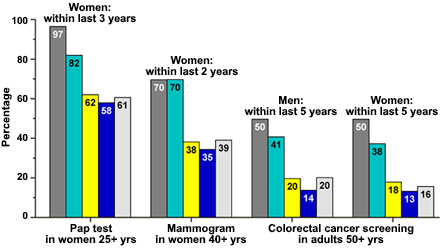|
|
||||||||||||||||
|
|
|
|
|
|||||||||||||
|
|
Control and Prevention Division of Cancer Prevention and Control 4770 Buford Hwy, NE MS K-64 Atlanta, GA 30341-3717 Call: 1 (800) CDC-INFO TTY: 1 (888) 232-6348 FAX: (770) 488-4760 E-mail: cdcinfo@cdc.gov Submit a Question Online |
|
|
|
Reducing Cancer DisparitiesAmericans can modify lifestyles to reduce individual risk for cancer—tobacco use, physical activity, and nutrition—and improve early detection. CDC and other public health agencies, health care providers, and communities of all racial and ethnic groups must become partners in a national effort to:
Greatest Disparities in the Use of Cancer Screening Tests: 
Text description of chart also available Source: 2000 National Health Interview Survey Minority groups' access to cancer care and clinical trials needs to be expanded continuously to ensure that people in these communities are provided the same quality, access, and state-of-the-art technology that patients in major care centers receive. Because fear of cancer, cost, and lack of physician referral are common barriers to cancer screening and other preventive services, health care providers play a critical role in increasing the use of preventive services. Physicians must address their patients' fears by describing how screening saves lives. Health care providers must recommend preventive services and communicate with their patients about low-cost or free cancer screening services like the National Breast and Cervical Cancer Early Detection Program (NBCCEDP). Because many women in minority populations have limited means or do not know how to access cancer treatment specialists, physicians must act as trusted referral sources.
Page last reviewed: July 11, 2006
Page last updated: July 11, 2006 Content source: Division of Cancer Prevention and Control, National Center for Chronic Disease Prevention and Health Promotion |
|
||||||||||||||||||||||||||||||||||||||||||||||||||||||||||||
|
|
|
||||||||||||
|